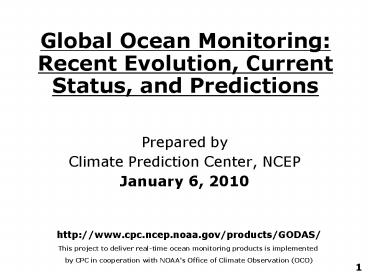Global Ocean Monitoring: Recent Evolution, Current Status, and Predictions - PowerPoint PPT Presentation
1 / 43
Title:
Global Ocean Monitoring: Recent Evolution, Current Status, and Predictions
Description:
Sea surface temperature (SST) anomalies (top-left), anomaly tendency (top-right), Outgoing Long-wave Radiation (OLR) anomalies (middle-left), ... – PowerPoint PPT presentation
Number of Views:173
Avg rating:3.0/5.0
Title: Global Ocean Monitoring: Recent Evolution, Current Status, and Predictions
1
Global Ocean Monitoring Recent Evolution,
Current Status, and Predictions
- Prepared by
- Climate Prediction Center, NCEP
- January 6, 2010
http//www.cpc.ncep.noaa.gov/products/GODAS/ This
project to deliver real-time ocean monitoring
products is implemented by CPC in cooperation
with NOAA's Office of Climate Observation (OCO)
2
Outline
- Overview
- Recent highlights
- Pacific/Arctic Ocean
- Indian Ocean
- Atlantic Ocean
- CFS SST Predictions
3
(No Transcript)
4
Global SST Anomaly (0C) and Anomaly Tendency
5
Global SSH/HC Anomaly (cm/oC ) and Anomaly
Tendency
6
(No Transcript)
7
Tropical Pacific Ocean
8
Evolution of Pacific NINO SST Indices
Nino 3
9
NINO3.4 Heat Budget 09/10 El Nino
The large warming tendency in Oct-Nov is largely
due to Qu, suggesting that influences of
subsurface temperature anomalies on the recent
SSTA changes are likely small. The small
tendency in Dec 09 suggests that the El Nino
likely reached its peak phase.
Balance in heat budget (dT/dt RHS) was poor in
Jul-Sep when intraseaonal variability is large.
Qu and QwQzz contributed to the warming tendency
in Mar-May.
Qq and Qu contributed to the decay of the cold
anomaly in the early spring 09.
10
09/10 El Nino
08/09 La Nina
07/08 La Nina
11
Evolution of Equatorial Pacific SST (ºC), 0-300m
Heat Content (ºC), 850-mb Zonal Wind (m/s), and
OLR (W/m2)? Anomaly
12
Evolution of Equatorial Pacific Surface Zonal
Current Anomaly (cm/s)
13
Equatorial Pacific Temperature Anomaly
TAO
GODAS
TAO climatology used
14
Oceanic Kelvin Wave Indices
15
Oceanic Kelvin Wave Indices
06/07 El Nino
09/10 El Nino
16
(No Transcript)
17
North Pacific Arctic Ocean
18
(No Transcript)
19
PDO index
20
(No Transcript)
21
- Upwelling north of 30N was well above-normal in
Dec 09.
22
http//coastwatch.pfel.noaa.gov/FAST
23
- Upwelling has been above-normal during the
winter of 06/07, 07/08 and 09/10.
24
Tropical Indian Ocean
25
Evolution of Indian Ocean SST Indices
26
(No Transcript)
27
(No Transcript)
28
(No Transcript)
29
Tropical Atlantic Ocean
30
Evolution of Tropical Atlantic SST Indices
- Tropical North Atlantic SST (TNA) was
above-normal in Jul-Dec. - Tropical South Atlantic SST (TSA remained
above-normal. - - Meridional Gradient Mode (TNA-TSA) was
near-normal. - ATL3 SST was near-normal.
31
?
32
North Atlantic Ocean
33
(No Transcript)
34
(No Transcript)
35
(No Transcript)
36
CFS SST Predictions and Ocean Initial Conditions
37
CFS Niño3.4 SST Predictions from Different
Initial Months
38
CFS DMI SST Predictions from Different Initial
Months
39
CFS Tropical North Atlantic (TNA) SST Predictions
from Different Initial Months
40
CFS Pacific Decadal Oscillation (PDO) Index
Predictions from Different Initial Months
PDO is the first EOF of monthly ERSSTv3b anomaly
in the region of 110oE-100oW, 20oN-60oN. CFS
PDO index is the standardized projection of CFS
SST forecast anomalies onto the PDO EOF pattern.
Fig. M4. CFS Pacific Decadal Oscillation (PDO)
index predictions from the latest 9 initial
months. Displayed are 40 forecast members (brown)
made four times per day initialized from the last
10 days of the initial month (labeled as
ICMonthYear) as well as ensemble mean (blue) and
observations (black). The hindcast climatology
for 1981-2006 was removed, and replaced by
corresponding observation climatology for the
same period. Anomalies were computed with respect
to the 1971-2000 base period means.
41
(No Transcript)
42
Backup Slides
43
Data Sources and References
- Optimal Interpolation SST (OI SST) version 2
(Reynolds et al. 2002) - SST 1971-2000 base period means (Xue et al.
2003) - NCEP CDAS winds, surface radiation and heat
fluxes - NESDIS Outgoing Long-wave Radiation
- NDBC TAO data (http//tao.noaa.gov)
- PMEL TAO equatorial temperature analysis
- NCEPs Global Ocean Data Assimilation System
temperature, heat content, currents (Behringer
and Xue 2004) - Aviso Altimetry Sea Surface Height
- Ocean Surface Current Analyses Realtime
(OSCAR)































